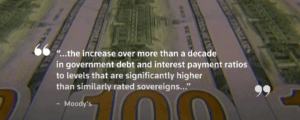I. Core Logic and Background of the Downgrade
- Trigger Factors
- Deteriorating Debt and Interest Burden: The U.S. federal debt-to-GDP ratio is projected to rise from 98% in 2024 to 134% by 2035, with interest payments increasing from 73% to 78% of total expenditures.
- Unsustainable Fiscal Policy: Republican-led tax cuts could add 3–5trilliontothedebtoverthenextdecade.Thefiscaldeficitforthefirsthalfof2025alreadyreached3–5trilliontothedebtoverthenextdecade.Thefiscaldeficitforthefirsthalfof2025alreadyreached1.3 trillion, the second-highest semi-annual level in history.
- Consensus Among Rating Agencies: Following S&P (2011) and Fitch (2023), Moody’s downgrade marks the loss of the U.S.’s AAA rating across all three major agencies, signaling systemic fiscal risks.
- Market Warning Signals
- Policy Gridlock Risks: Partisan divisions threaten fiscal reforms, with debt ceiling negotiations likely to become a political battleground.
- Erosion of Dollar Confidence: The downgrade weakens the perception of U.S. debt as a “risk-free” asset, potentially accelerating shifts in global reserve currency dynamics.
II. Immediate Market Reactions
- Equity Markets: Mixed Signals
- S&P 500: Closed at 5,945.29 (-0.22%) on May 20, 2025, reflecting caution amid growth concerns.
- Dow Jones: Rose 0.17% to 42,726.25, buoyed by defensive sectors and blue-chip stability.
- Nasdaq: Fell 0.42% to 19,130.98, with tech stocks (Palantir, Tesla, Nvidia) underperforming due to higher borrowing cost fears.
- Context: Prior gains (Nasdaq +7%, S&P +5%, Dow +3% the previous week) were driven by U.S.-China tariff reductions, but the downgrade triggered profit-taking, especially in growth-sensitive tech.
- Bond Market: Rising Yields
- 10-Year Treasury Yield: Jumped to 4.485% (+0.99%) on May 20, peaking at 4.55% intraday.
- 30-Year Yield: Surged to 5.02%, reflecting heightened long-term debt sustainability fears.
- Implications: Higher yields may pressure government and corporate borrowing, stifling economic growth. Analysts warn of a “reckoning” for fiscal imprudence (Mark McCormick, TD Securities).
- Gold: Safe-Haven Surge
- Price: Gold futures rose 1.62% to $3,238.70/oz on May 20, extending 2025’s 23.1% rally.
- Drivers: Dollar weakness, trade tensions, and the downgrade amplified demand for alternatives to U.S. dollar-denominated assets.
III. Economic Outlook and Policy Risks
- Macroeconomic Weakness
- Q1 2025 GDP: Contracted 0.3% (annualized), the worst since 2022, signaling stagflation risks.
- Tariff Policy Impact: Trump-era tariffs, if reinstated, could exacerbate inflation (60% tariffs on Chinese EVs) and unemployment.
- Monetary Policy Dilemma
- Fed’s Stance: Atlanta Fed President Raphael Bostic flagged persistent inflation, projecting only one 2025 rate cut but stressing “3–6 months of clarity” needed.
- Market Expectations: Rate cuts remain contingent on fiscal discipline progress, which the downgrade complicates.
IV. Analyst Perspectives
- Bearish Views:
- Peter Boockvar (Bleakley): The downgrade is symbolic but critical, exposing long-ignored debt risks.
- Vasu Menon (OCBC): Accelerates the decline of “American exceptionalism,” favoring non-U.S. assets.
- Neutral/Constructive Views:
- Stephane Deo (Eleva Capital): Yield moves align with fundamentals; equities correcting from overbought levels.
- Michael Wilson (Morgan Stanley): Advises buying dips, citing reduced recession risks post-trade truce.
V. Long-Term Implications
- Fiscal Reforms Urgency
- Debt Trajectory: Without tax/spending adjustments, debt-to-GDP could exceed 130% by 2035, risking a sovereign debt crisis.
- Political Challenges: Bipartisan cooperation is essential but unlikely in an election year, raising default risks.
- Global Ramifications
- Dollar Hegemony: Erosion of trust in U.S. debt may accelerate dedollarization, boosting gold, cryptocurrencies, and rival currencies (yuan, euro).
- Asset Allocation Shifts: Pension funds and central banks could diversify away from Treasuries, raising U.S. financing costs.



+ There are no comments
Add yours